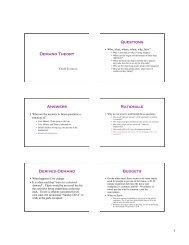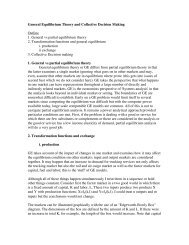multi-modal trip distribution: structure and application
multi-modal trip distribution: structure and application
multi-modal trip distribution: structure and application
Create successful ePaper yourself
Turn your PDF publications into a flip-book with our unique Google optimized e-Paper software.
Levinson <strong>and</strong> Kumar<br />
________________________________________________________________________<br />
subject to:<br />
M<br />
∑ (Pijm) = 1 (3)<br />
m=1<br />
where:<br />
Pijm = probability of using mode m on a <strong>trip</strong> from i to j (from mode choice model)<br />
Cijm = travel time from i to j using mode m<br />
f(Cijm) = friction (impedance) function (negative exponential) described in Tables 1 <strong>and</strong> 2<br />
In <strong>application</strong> of equation 2, the probabilities from the mode choice model are <strong>multi</strong>plied<br />
by the <strong>modal</strong> impedance on an O-D basis <strong>and</strong> summed to obtain composite impedance. A<br />
doubly constrained gravity model is used wherein, the impedance matrix for work <strong>trip</strong>s is<br />
balanced against each of the production <strong>and</strong> attraction (origin <strong>and</strong> destination) vectors to obtain<br />
the <strong>trip</strong> table for work <strong>trip</strong> purposes (this process is repeated for chained work <strong>trip</strong>s <strong>and</strong> each<br />
non-work <strong>trip</strong> purpose). These all-mode <strong>trip</strong> tables are <strong>multi</strong>plied by the mode choice<br />
probabilities to obtain vehicle <strong>trip</strong>s by class (SOV, HOV) <strong>and</strong> transit person <strong>trip</strong> tables (walk<br />
access, auto access) which are then assigned. In the feedback procedures described in an earlier<br />
paper ( 1 ), vehicle <strong>trip</strong>s are assigned for a single iteration, producing new O-D travel times. The<br />
new times are used to update <strong>modal</strong> probabilities <strong>and</strong> then impedance matrices. This process is<br />
continued, with the new dem<strong>and</strong> assigned to the congested network until convergence.<br />
Validation<br />
The travel time (Cij), <strong>multi</strong>-<strong>modal</strong> impedance functions (fij), <strong>and</strong> then dem<strong>and</strong> to be assigned<br />
(Tij) are updated after each iteration of route assignment to ensure consistency between input <strong>and</strong><br />
output travel times. Because of the travel time feedback method used, the model produces <strong>trip</strong>s,<br />
________________________________________________________________________<br />
December 17, 1996 8







